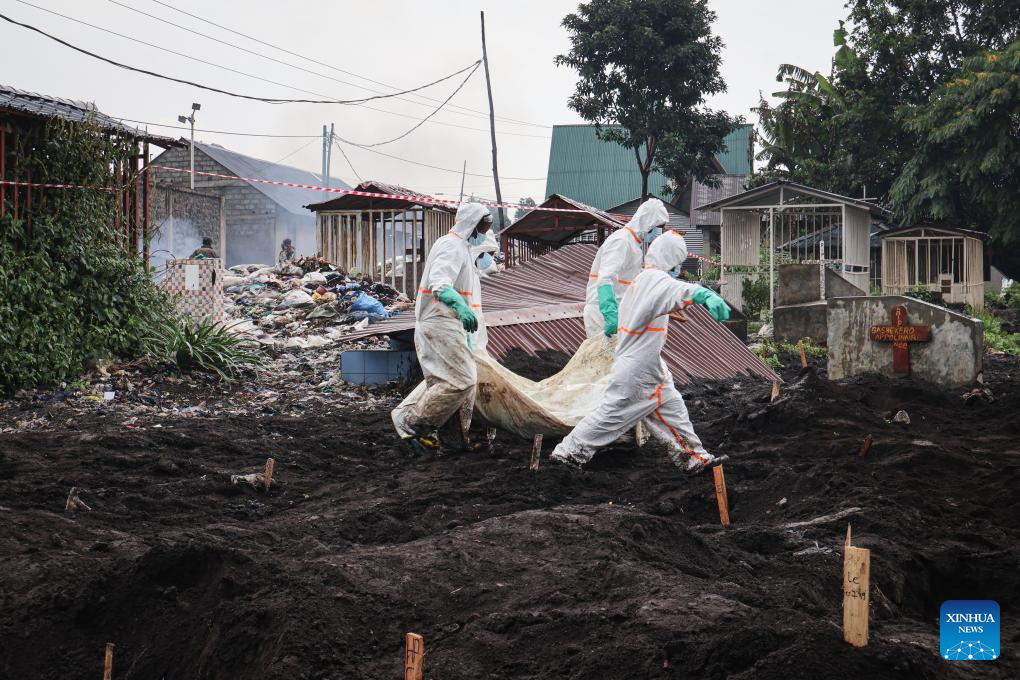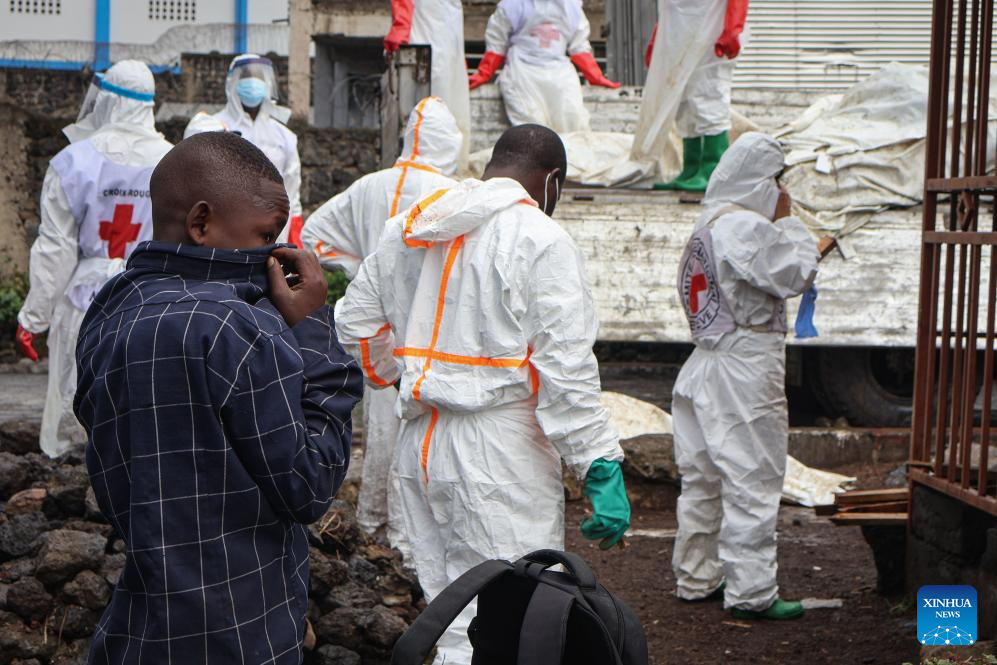
A health worker takes note at a burial site of the victims in Goma, the Democratic Republic of the Congo (DRC), Feb. 5, 2025.
Goma, the capital of North Kivu province and a key regional hub, remains in turmoil after the March 23 Movement (M23) rebels on Jan. 26 asserted that they had taken control of the city, a claim the Congolese government has not recognized.
"There are more than 2,000 bodies to be buried," said Patrick Muyaya, spokesperson for the DRC government, on Monday evening during a press briefing in Kinshasa, the capital of the Central African country, referring to the aftermath of the hostilities in Goma. (Photo by Zanem Nety Zaidi/Xinhua)
UNITED NATIONS, Feb. 5 (Xinhua) -- A UN official in occupied Goma, Democratic Republic of the Congo (DRC), said on Wednesday the city is in crisis as humanitarians fight the risk of epidemics while providing relief.
"In Goma, we remain under occupation; the situation is still highly volatile, with a persistent risk of escalation," said Vivian van de Perre, the UN secretary-general's deputy special representative, during a video linkup with reporters.
She said the M23 rebels and the Rwandan Defense Forces (RDF) continue to consolidate their control over Goma and most of the territories of North Kivu province the armed group previously seized.
"All exit routes from Goma are under their control, and the airport, also under M23 control, is closed," van de Perre said. "The escalating violence has led to immense human suffering, displacement and a growing humanitarian crisis."
Van de Perre said the UN mission in the DRC, known as MONUSCO, also operates in a very challenging environment. Its key sites in the regional hub are overwhelmed with both UN personnel and Congolese seeking shelter. UN facilities were neither designed nor staffed for large-scale, long-term accommodations.
She said the pressure on critical resources -- such as water, food, sanitation, and shelter -- is growing.
"Despite these obstacles, MONUSCO continues to protect UN personnel and shelter vulnerable populations under international humanitarian law," van de Perre said. "Non-critical UN international and national staff have been relocated, while critical MONUSCO and humanitarian personnel stay to provide protection and aid."
She said the latest assessment from the UN country team is that about 2,000 bodies were recovered from the streets, with another 900 plus bodies in morgues. Also, there still are many decomposing bodies uncollected. In addition to concerns about disease outbreaks, officials are worried about ethnic violence erupting.
Van de Perre said sites for the internally displaced north of Goma have been abandoned. The occupants have taken their personal belongings.
She didn't know if the displaced were encouraged to move out, but the sites were dismantled entirely. ■

Health staff transfer bodies of victims in Goma, the Democratic Republic of the Congo (DRC), Feb. 5, 2025.
Goma, the capital of North Kivu province and a key regional hub, remains in turmoil after the March 23 Movement (M23) rebels on Jan. 26 asserted that they had taken control of the city, a claim the Congolese government has not recognized.
"There are more than 2,000 bodies to be buried," said Patrick Muyaya, spokesperson for the DRC government, on Monday evening during a press briefing in Kinshasa, the capital of the Central African country, referring to the aftermath of the hostilities in Goma. (Photo by Zanem Nety Zaidi/Xinhua)

Health staff transfer bodies of victims in Goma, the Democratic Republic of the Congo (DRC), Feb. 5, 2025.
Goma, the capital of North Kivu province and a key regional hub, remains in turmoil after the March 23 Movement (M23) rebels on Jan. 26 asserted that they had taken control of the city, a claim the Congolese government has not recognized.
"There are more than 2,000 bodies to be buried," said Patrick Muyaya, spokesperson for the DRC government, on Monday evening during a press briefing in Kinshasa, the capital of the Central African country, referring to the aftermath of the hostilities in Goma. (Photo by Zanem Nety Zaidi/Xinhua)

Health staff transfer bodies of victims in Goma, the Democratic Republic of the Congo (DRC), Feb. 5, 2025.
Goma, the capital of North Kivu province and a key regional hub, remains in turmoil after the March 23 Movement (M23) rebels on Jan. 26 asserted that they had taken control of the city, a claim the Congolese government has not recognized.
"There are more than 2,000 bodies to be buried," said Patrick Muyaya, spokesperson for the DRC government, on Monday evening during a press briefing in Kinshasa, the capital of the Central African country, referring to the aftermath of the hostilities in Goma. (Photo by Zanem Nety Zaidi/Xinhua)

Health staff transfer bodies of victims in Goma, the Democratic Republic of the Congo (DRC), Feb. 5, 2025.
Goma, the capital of North Kivu province and a key regional hub, remains in turmoil after the March 23 Movement (M23) rebels on Jan. 26 asserted that they had taken control of the city, a claim the Congolese government has not recognized.
"There are more than 2,000 bodies to be buried," said Patrick Muyaya, spokesperson for the DRC government, on Monday evening during a press briefing in Kinshasa, the capital of the Central African country, referring to the aftermath of the hostilities in Goma. (Photo by Zanem Nety Zaidi/Xinhua)

This photo shows a burial site of the victims in Goma, the Democratic Republic of the Congo (DRC), Feb. 5, 2025.
Goma, the capital of North Kivu province and a key regional hub, remains in turmoil after the March 23 Movement (M23) rebels on Jan. 26 asserted that they had taken control of the city, a claim the Congolese government has not recognized.
"There are more than 2,000 bodies to be buried," said Patrick Muyaya, spokesperson for the DRC government, on Monday evening during a press briefing in Kinshasa, the capital of the Central African country, referring to the aftermath of the hostilities in Goma. (Photo by Zanem Nety Zaidi/Xinhua)

Health staff transfer bodies of victims in Goma, the Democratic Republic of the Congo (DRC), Feb. 5, 2025.
Goma, the capital of North Kivu province and a key regional hub, remains in turmoil after the March 23 Movement (M23) rebels on Jan. 26 asserted that they had taken control of the city, a claim the Congolese government has not recognized.
"There are more than 2,000 bodies to be buried," said Patrick Muyaya, spokesperson for the DRC government, on Monday evening during a press briefing in Kinshasa, the capital of the Central African country, referring to the aftermath of the hostilities in Goma. (Photo by Zanem Nety Zaidi/Xinhua)

Health staff transfer bodies of victims in Goma, the Democratic Republic of the Congo (DRC), Feb. 5, 2025.
Goma, the capital of North Kivu province and a key regional hub, remains in turmoil after the March 23 Movement (M23) rebels on Jan. 26 asserted that they had taken control of the city, a claim the Congolese government has not recognized.
"There are more than 2,000 bodies to be buried," said Patrick Muyaya, spokesperson for the DRC government, on Monday evening during a press briefing in Kinshasa, the capital of the Central African country, referring to the aftermath of the hostilities in Goma. (Photo by Zanem Nety Zaidi/Xinhua)
